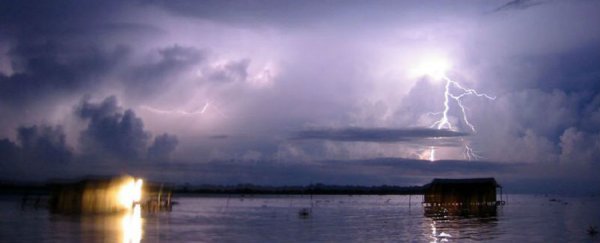If you really want to see nature at its most awe-inspiring and angry, head to Lake Maracaibo in Venezuela. As the BBC reports, it's officially the most electric place on Earth, with thousands of lightning strikes every hour at peak times - that adds up to an average of 260 days of storms in every 365-day year. Locals refer to it variously as the Beacon of Maracaibo, Catatumbo lightning, or simply "the everlasting storm".
Venezuela's close proximity to the equator is one reason for the meteorological phenomenon, where the temperatures are higher and the storms are more intense. When the lightning is 'in season', usually in October, you can catch an average of 28 flashes a minute. This drops during the drier months of January and February.
Scientists have long sought reasons for this record-breaking microclimate, but no one has been able to prove there's any more to it than a unique combination of terrain, location, and wind patterns. At one point it was thought that uranium in the bedrock at Lake Maracaibo attracted lightning strikes, while more recently an abundance of methane in the air was suggested as the underlying reason, but there's a lack of evidence for either theory.
"A lot of the [lightning] hotspots are tied to features in the terrain - slopes of mountain ranges, curved coastlines, combinations of those," Daniel Cecil from the Global Hydrology and Climate Centre told the BBC. "Having irregularities like that in the terrain can help generate wind patterns and heating or cooling patterns that would boost the likelihood of thunderstorms."
Lightning is caused by small, frozen ice crystals colliding with raindrops in thunderclouds. The friction produces an electric charge that fills up the cloud: positive charges (protons) at the top and negative charges (electrons) at the bottom. This in turn generates a positive electric charge underneath the ground, one that eventually finds its way to the surface in a blast of lightning (via a conveniently placed metal pole or isolated tree, if one is available).
But back to Lake Maracaibo. The largest lake in South America, it flows out into the Caribbean Sea and is surrounded on the three other sides by high mountain ridges that form part of the Andes. As the hot tropical sun evaporates water from the lake and the surrounding wetland, trade winds from the sea push this warm air into cold air coming down from the mountains. The resulting cumulonimbus clouds can reach up to 12 kilometres high (39,000 feet), and produce the alarmingly regular lightning storms.
And you don't necessarily have to travel to the port of Maracaibo itself to watch - the bolts can be seen up to 400 kilometres (250 miles) away, and in times gone by were said to have helped sailors to navigate the coastline.
